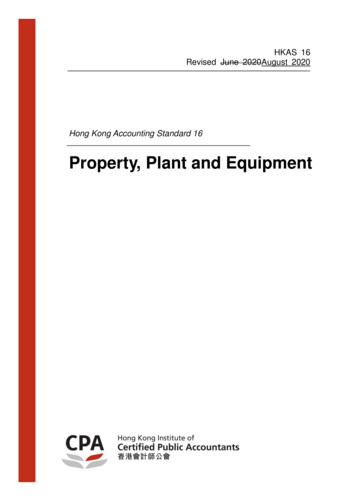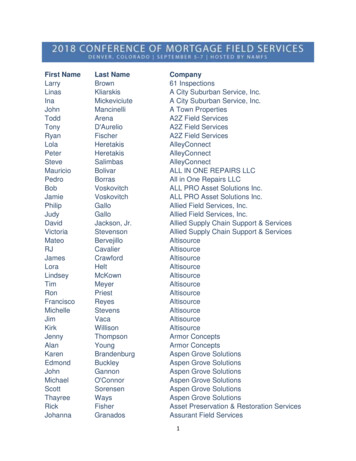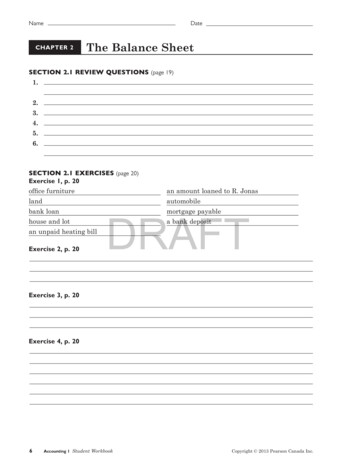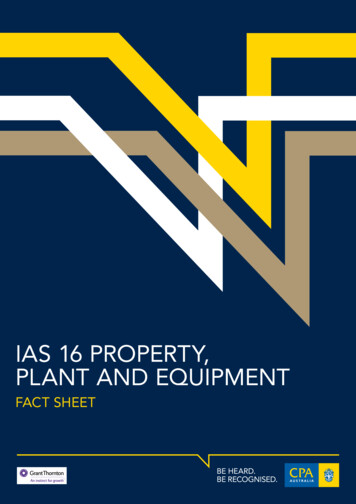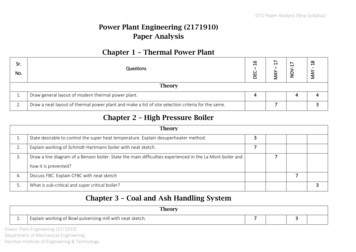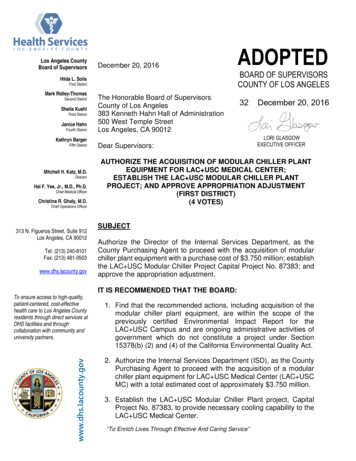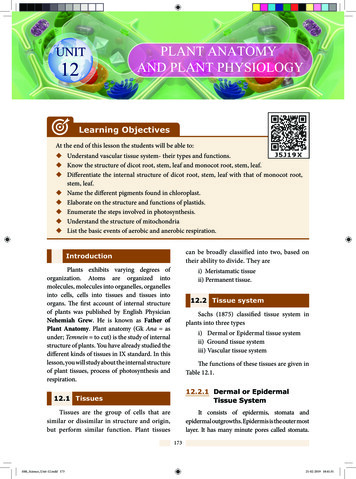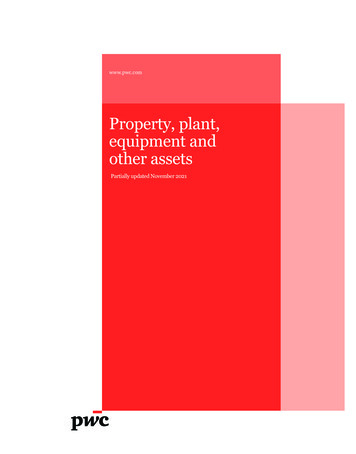
Transcription
www.pwc.comProperty, plant,equipment andother assetsPartially updated November 2021
About the Property, plant, equipmentand other assets guidePwC is pleased to offer our updated accounting and financial reporting guide for Property, plant,equipment and other assets. Although many view the accounting for property, plant, and equipmentto be relatively straightforward, there is limited technical guidance and there can be many areas thatrequire judgment. Some areas, such as construction in process, capitalized software, long-lived assetimpairment, and asset disposals, can be complex. In addition to these areas, this guide addresses avariety of other topics including the accounting for asset acquisitions, asset retirement obligations,environmental obligations, insurance recoveries, and research and development costs and fundingarrangements.This guide summarizes the applicable accounting literature, including relevant references to andexcerpts from the FASB’s Accounting Standards Codification (the Codification). It also provides ourinsights and perspectives, interpretative and application guidance, illustrative examples, anddiscussion on emerging practice issues.This guide should be used in combination with a thorough analysis of the relevant facts andcircumstances, review of the authoritative accounting literature, and appropriate professional andtechnical advice.References to US GAAPDefinitions, full paragraphs, and excerpts from the FASB’s Accounting Standards Codification areclearly designated, either within quotes in the regular text or enclosed within a shaded box. In someinstances, guidance was cited with minor editorial modification to flow in the context of the PwCGuide. The remaining text is PwC’s original content.References to other PwC guidanceThis guide provides general and specific references to chapters in other PwC guides to assist users infinding other relevant information. References to other guides are indicated by the applicable guideabbreviation followed by the specific section number. The other PwC guides referred to in this guide,including their abbreviations, are: Business combinations and noncontrolling interests (BCG) Consolidation (CG) Derivatives and hedging (DH) Equity method investments and joint ventures (EM) Fair value measurements (FV) Financial statement presentation (FSP) Financing transactions (FG)
About this guide Income taxes (TX) Leases (LG) Revenue from contracts with customers (RR) Transfers and servicing of financial assets (TS) Utilities and power companies (UP)Summary of significant changesThe following is a summary of recent noteworthy revisions made to the guide. Additional updates maybe made to future versions to keep pace with significant developments.Revisions made in November 2021Chapter 2: Asset acquisitions PPE 2.1 was updated to include guidance regarding the treatment of a change in interest of asubsidiary that is not a business that does not result in a loss of control. PPE 2.3.1 was updated to provide additional guidance on the measurement elections availablewhen an entity acquires assets through the issuance of equity interests.Chapter 5: Long-lived asset impairment and assets held for sale PPE 5.3.1.4 was updated to include incremental guidance on assessing the held for sale criteriawhen there is a planned sale and leaseback transaction under ASC 842, Leases.Chapter 6: Asset disposals The order of certain sections within PPE 6 was rearranged. Certain sections related totransitioning to ASC 610-20 were also removed.Chapter 8: Other assets PPE 8.2.1 was updated to include additional clarifying guidance on the recognition of insurancerecoverable assets.Revisions made in May 2021Chapter 5: Long-lived asset impairment and assets held for sale Figure PPE 5-2 was added to PPE 5.2 to illustrate the model for assessing the impairment oflong-lived assets that are held and used. PPE 5.2.1.1 was updated to include guidance for assessing the impairment of assets includedwithin entity-wide asset groups. PPE 5.2.1.2 was added to provide guidance on accounting for changes to asset groups.
About this guide PPE 5.2.3.1 was added to include considerations when individual assets within a broader assetgroup experience an impairment indicator. PPE 5.2.4.4 through PPE 5.2.4.15 were updated to include incremental guidance andconsiderations for specific assets and liabilities included in asset groups (e.g., debt and other longterm obligations, income taxes, and amounts in AOCI). PPE 5.3.1.1 through PPE 5.3.1.7 were updated to include additional guidance when assessingeach of the criteria required to be met to qualify for held for sale classification. PPE 5.3.3.2 was updated to include goodwill impairment considerations for scenarios when adisposal group that previously met the definition of a business (i.e., prior to the adoption of ASU2017-01) no longer meets the definition of a business. PPE 5.3.3.4 was added to include guidance regarding the treatment of amounts included in AOCIwhen determining the carrying amount of a disposal group that is a foreign entity. PPE 5.3.5 was added to include guidance for newly acquired assets that are classified as held forsale immediately upon acquisition.Revisions made in March 2021Chapter 4: Depreciation and amortization PPE 4.2.1.4 was added to include guidance for determining the useful lives of acquired defensiveintangible assets. Example PPE 4-3 in PPE 4.3.2.2 was updated to include clarifying guidance for calculatingdepreciation expense when using the sum-of-the-years’-digits method.Chapter 6: Asset disposals PPE 6.4.1.1 was updated to include additional guidance and practical considerations whenaccounting for the abandonment of right-of-use assets under ASC 842.Chapter 8: Other assets PPE 8.2.5 was updated to include additional guidance related to accounting for businessinterruption insurance policy recoveries. PPE 8.3.3 was updated to include additional considerations for determining whether researchand development (R&D) costs should be capitalized or expensed. PPE 8.3.4 through PPE 8.3.4.5 were updated to include interpretive guidance for R&D fundingarrangements structured through a newly-created entity (PPE 8.3.4.1) and direct R&D fundingarrangements (PPE 8.3.4.2 through PPE 8.3.4.5), including considerations for determining theaccounting guidance to apply to these arrangements (e.g., ASC 730-20, ASC 470-10).
About this guideCopyrightsThis publication has been prepared for general informational purposes and does not constituteprofessional advice on facts and circumstances specific to any person or entity. You should not actupon the information contained in this publication without obtaining specific professional advice. Norepresentation or warranty (express or implied) is given as to the accuracy or completeness of theinformation contained in this publication. The information contained in this publication was notintended or written to be used, and cannot be used, for purposes of avoiding penalties or sanctionsimposed by any government or other regulatory body. PricewaterhouseCoopers LLP, its members,employees, and agents shall not be responsible for any loss sustained by any person or entity thatrelies on the information contained in this publication. Certain aspects of this publication may besuperseded as new guidance or interpretations emerge. Financial statement preparers and other usersof this publication are therefore cautioned to stay abreast of and carefully evaluate subsequentauthoritative and interpretative guidance.The FASB Accounting Standards Codification material is copyrighted by the Financial AccountingFoundation, 401 Merritt 7, Norwalk, CT 06856, and is reproduced with permission.
Chapter 1:Capitalization of costs—updated October 2020
Capitalization of costs1.1Capitalization of costs–chapter overviewThis chapter focuses on property, plant, and equipment (PP&E) costs and provides guidance on costcapitalization, including what types of costs are capitalizable and when capitalization should begin.For guidance on assets acquired through an asset acquisition refer to PPE 2. For guidance on assetsacquired through a business combination refer to PwC’s Business combinations and noncontrollinginterests guide.ASC 360, Property, Plant, and Equipment is the authoritative US GAAP for PP&E and defines property, plant,and equipment as follows:Excerpt from ASC 360-10-05-3Property, plant, and equipment typically consist of long-lived tangible assets used to create anddistribute an entity's products and services and include:a. Land and land improvementsb. Buildingsc. Machinery and equipmentd. Furniture and fixturesAlthough ASC 360-10-05-3 defines PP&E, it does not include any specific guidance for capitalization ofcosts incurred during the development of self-constructed assets for a reporting entity’s own use (i.e.,capital projects).Despite the lack of authoritative guidance, many of the concepts included in the 2001 proposedStatement of Position from the Financial Reporting Executive Committee of the AICPA (FinREC),Accounting for Certain Costs and Activities Related to Property, Plant, and Equipment reflect currentpractice regarding the accounting treatment for the capitalization of costs for capital projects. In 2003,the FinREC redeliberated and submitted a proposed Statement of Position to the FASB for approval(herein referred to as the unissued PPE SOP). Although it was not approved for issuance by the FASBand is nonauthoritative, the unissued PPE SOP contains guidance related to the capitalization of costsof an asset constructed or obtained for a reporting entity’s own use that is helpful when considering theaccounting treatment for such costs.This chapter provides guidance on accounting for costs incurred as part of capital projects (PPE 1.2),including a table summarizing the nature of costs that are usually incurred when acquiring orconstructing assets and the applicable accounting treatment (PPE 1.2.2). In addition, it addressesmatters pertaining to the capitalization of costs, such as the accounting for incurred interest (PPE 1.3),maintenance expenses, including major maintenance (PPE 1.4), long-term service agreements (PPE1.4.2), government incentives (PPE 1.6), real estate projects for sale or rental (PPE 1.7), and other costs(PPE 1.5).During the acquisition, construction, development, and/or normal operation of an asset, companiesmay also incur costs related to asset retirement and/or environmental obligations. For detailsregarding the accounting for asset retirement obligations refer to PPE 3. For details regarding theaccounting for environmental obligations refer to PPE 9.1-2
Capitalization of costs1.2Accounting for capital projectsProperty, plant, and equipment (PP&E) is reported at its historical cost, which is the amount of cash,or its equivalent, paid to acquire an asset, and is commonly adjusted subsequently for amortization,depreciation, and/or impairment. The guidance for the costs to be capitalized when acquiring PP&Ecan be found in ASC 360-10.Excerpt from ASC 360-10-30-1[T]he historical cost of acquiring an asset includes the costs necessarily incurred to bring it to thecondition and location necessary for its intended use.Activities necessary to acquire PP&E and bring it to the condition and location necessary for itsintended use is defined in ASC 360-10-20.Definition from ASC 360-10-20Activities: The term activities is to be construed broadly. It encompasses physical construction of theasset. In addition, it includes all the steps required to prepare the asset for its intended use. Forexample, it includes administrative and technical activities during the preconstruction stage, such asthe development of plans or the process of obtaining permits from governmental authorities. It alsoincludes activities undertaken after construction has begun in order to overcome unforeseen obstacles,such as technical problems, labor disputes, or litigation.When determining which costs should be capitalized for assets that are self-constructed, it is importantto distinguish between those costs that are “necessarily incurred” and those that could have beenavoided by the reporting entity. For example, penalties or fines from the mismanagement of a capitalproject would not qualify for capitalization as such amounts are not “necessarily incurred” to bring theasset to its intended use. Alternatively, costs relating to unforeseen obstacles encountered duringconstruction (such as additional excavation costs, or additional required permitting) would likelyqualify for capitalization. Determining which costs are “necessarily incurred” for a capital projectrequires judgment.Generally, costs incurred for replacements or betterments of property, plant, and equipment can becapitalized when they extend the life or increase the functionality of the asset in question; otherwise,they should be expensed as incurred (e.g., repairs and maintenance). See PPE 1.4 for information onaccounting for maintenance costs.Capital costs may include labor, materials and supplies, transportation, engineering services, certainoverhead costs, insurance, employee benefits, taxes, and interest. Similarly, an expenditure that adds tothe productive capacity or improves the efficiency of an existing asset can be considered a capital item.Costs incurred during construction that are directly attributable to placing it into service should becapitalized. Costs that are not necessary in readying an asset for use should be recognized as an expenseas incurred.ASC 970, Real Estate - General, includes incremental guidance on capitalizing the costs of real estatedeveloped for sale or rental. That guidance explicitly excludes capital projects constructed for areporting entity’s own use. However, in the absence of other authoritative guidance, reporting entities1-3
Capitalization of costsoften apply the guidance in ASC 970 by analogy in developing their overall capitalization policies. SeePPE 1.7 for information on specific considerations for capital projects built for sale or rental.1.2.1Initial measurement (capital projects)The cost of acquiring an asset includes the costs necessarily incurred to bring it to the condition andlocation necessary for its intended use. The unissued PPE SOP identified four stages during whichcosts may be incurred related to long-lived assets: the preliminary stage, the pre-acquisition stage, theconstruction stage, and the in-service stage.Figure PPE 1-1 in PPE 1.2.2 contains a summary of the accounting for common types of costs incurredduring all stages of construction of a capital project. The following sections discuss what costs can becapitalized during each of the stages.1.2.1.1Preliminary stage (capital projects)The first stage during which costs are incurred related to long-lived assets is the preliminary stage.During the preliminary stage, the project is not considered probable of being constructed. Accordingly,given the high degree of uncertainty about the future economic benefits, costs incurred during thisstage are expensed as incurred.The preliminary stage commences at the beginning of a project and lasts until the acquisition orconstruction of the specific long-lived asset is considered probable, as defined in ASC 450,Contingencies. In assessing probability, the reporting entity should consider whether (1) management,having the requisite authority, has implicitly or explicitly authorized and committed to funding theacquisition or construction of a specific asset, (2) the financial resources are available consistent withsuch authorization, and (3) the ability exists to meet the necessary local and other governmentalregulations.During the preliminary stage, activities are performed exploring the opportunities for acquisition orconstruction of property, plant, and equipment. A reporting entity may conduct feasibility studies andother activities related to asset selection. The reporting entity may incur costs to obtain an option toacquire one or more items of PP&E during this stage. Some examples of other costs that may beincurred during this stage include those related to surveying, zoning, engineering studies, designlayouts, traffic studies, and obtaining management’s approval to move forward with a particularcapital project. Some of these costs may be incurred in one or more of the stages of a project.Therefore, the assessment of probability of a project when the costs are incurred is key to thecapitalization decision.Accounting for costs during the preliminary stage is consistent with guidance in ASC 720-15, OtherExpenses, Start-up Costs, which addresses costs associated with start-up activities, including thoserelated to new capital projects, and states that such costs should be expensed as incurred.The accounting for costs to arrange financing for the construction of a new capital project isspecifically addressed by ASC 835, Interest. See PPE 1.3 for further discussion regarding capitalizedinterest.1-4
Capitalization of costs1.2.1.2Pre-acquisition stage (capital projects)The pre-acquisition stage begins when the construction of specific property, plant, or equipment isprobable but prior to the start of construction. The unissued PPE SOP differentiates between costs thatare directly identifiable with the specific PP&E and those that are an allocated or overhead cost.Directly identifiable costs should be capitalized in the pre-acquisition stage whereas allocated and otheroverhead costs should be expensed as incurred. Similarly, in the general guidance on real estate, ASC 970340-25-3 states that costs that meet specified criteria should be capitalized once the project is probable.Excerpt from ASC 970-340-25-3All other costs related to a property that are incurred before the entity acquires the property, or beforethe entity obtains an option to acquire it, shall be capitalized if all of the following conditions are metand otherwise shall be charged to expense as incurred:a.The costs are directly identifiable with the specific property.b. The costs would be capitalized if the property were already acquired.c.Acquisition of the property or of an option to acquire the property is probable (that is, likely tooccur). This condition requires that the prospective purchaser is actively seeking to acquire theproperty and has the ability to finance or obtain financing for the acquisition and that there is noindication that the property is not available for sale.Directly identifiable costs include the following: Incremental direct costs of PP&E pre-acquisition activities incurred for the specific PP&E intransactions with independent third parties. Certain costs directly related to pre-acquisition activities performed by the reporting entity (or bythird parties who are not independent of the reporting entity) for the specific PP&E. These costsinclude payroll and payroll benefit-related costs (e.g., costs of health insurance) for employeeswho devote time to a PP&E pre-acquisition stage activity, to the extent of time the employeesspent directly on that activity and in proportion to the total hours employed (includingcompensated absences). Additionally, only the service component of net periodic pension andpostretirement costs should be capitalized. However, rent, depreciation, and other occupancycosts associated with the physical space occupied by employees should be charged to expense asincurred, as they are not directly identifiable costs. Payments to obtain an option to acquire PP&E. The reporting entity should evaluate whether theoption is a derivative and should be accounted for under ASC 815. If the option does not meet thedefinition of a derivative, the unissued PPE SOP indicates that the option should be carried at thelower of cost or fair value. Reductions in the recorded value of an option should be charged toexpense. If the fair value less cost to sell of the option subsequently increases, amounts previouslycharged to expense may not be reinstated to the balance sheet.General and administrative costs and overhead costs should be charged to expense as incurred,regardless of whether those costs are incurred internally or outsourced to a third party. Those costsinclude all costs (including payroll and payroll benefit-related costs) of support functions, which1-5
Capitalization of costsinclude executive management, corporate accounting, acquisitions, purchasing, legal, officemanagement and administration, marketing, human resources, and information systems. Similarly, areporting entity that outsources its acquisitions department to a third party should charge the costs toexpense as incurred because an acquisitions department represents a support function and thereporting entity could choose to establish its own internal acquisitions department.If during the pre-acquisition stage the construction or acquisition of the specific long-lived asset isdetermined to no longer be probable, the capitalized costs related to the project should be assessed forimpairment under ASC 360. When evaluating whether the capitalized costs of a project that is nolonger probable of being completed are impaired, a reporting entity will need to determine whetherthe asset will be sold, abandoned, or held and used (e.g., to potentially be completed in the future).When determining the fair value of an impaired project, a rebuttable presumption exists that the fairvalue of costs incurred before the acquisition or construction stage is zero. Refer to PPE 6.4.1 forfurther discussion on assets to be abandoned. Refer to PPE 5.3 for additional information on the heldfor sale model. Refer to PPE 5.2 for additional information on the held and used model.1.2.1.3Construction stage (capital projects)The construction stage begins at the time the reporting entity obtains ownership of the PP&E orobtains the right to use the PP&E through an agreement (e.g., a lease). During this stage, costs areincurred to acquire, construct, or install the PP&E. This stage includes costs incurred prior to the longlived asset being available for its intended use. Examples of activities performed during this stageinclude planning for construction or installation once ownership (or the right to use) has beenacquired; constructing or installing PP&E; and supervising the construction of PP&E.Similar to the pre-acquisition stage, costs incurred during the construction stage that are directlyidentifiable should be capitalized. Directly identifiable costs include: Incremental direct costs of acquiring, constructing, or installing the PP&E incurred in transactionswith independent third parties. Certain costs directly related to activities performed by the reporting entity (or by third partieswho are not independent of the reporting entity) for the construction or installation of the specificPP&E, and costs directly related to preproduction test runs of PP&E that are necessary to get thePP&E ready for its intended use. These costs include only (1) payroll and payroll benefit-relatedcosts (including only the service cost component of net periodic pension and postretirement costs)of employees who devote time to a PP&E construction stage activity, to the extent of time theemployee spent directly on that activity and in proportion to the total hours employed (includingcompensated absences), (2) depreciation of machinery and equipment used directly in theconstruction or installation of PP&E, to the extent of time the machinery and equipment is useddirectly in that activity as a percentage of its expected useful life and incremental costs directlyassociated with the utilization of that machinery and equipment (e.g., fuel for such machinery),and (3) inventory used directly in the construction or installation of PP&E (including spare parts).1-6
Capitalization of costsRent, depreciation, and other occupancy costs associated with the physical space occupied byemployees are not directly identifiable costs and should be expensed as incurred, consistent with theaccounting for those types of costs within the pre-acquisition stage. General and administrative andoverhead costs should also be expensed as incurred, whether the costs are internal or paid to thirdparties.Directly identifiable costs should be distinguished from allocated or overhead costs. Directlyidentifiable costs should be capitalized, while other costs should be expensed as incurred. Overheadcosts are not directly related to the construction of the asset and should be expensed as incurred.Overhead costs should be expensed even when they relate to employees who are specifically involvedin the construction of the asset (e.g., occupancy costs specific to internal engineers who are directlyinvolved in the internal construction of PP&E are expensed). This is consistent with the conclusion inASC 350-40-30-3 for internal-use software, which precludes the capitalization of overhead costs.In addition, lease costs associated with ground or building operating leases that are incurred during aconstruction period should be recognized as lease expense if a company is developing a property for itsown use.In certain circumstances, there may be depreciation costs directly related to the construction project,such as depreciation of equipment used to build a long-lived asset for internal use. The depreciationcosts of the equipment used to build a long-lived asset are considered directly identifiable and shouldbe capitalized. On the other hand, depreciation related to the company's headquarters would beconsidered an indirect cost and should be charged to expense as incurred.As discussed in PPE 1.7, ASC 970 provides specific guidance for the construction of real estate assetsfor sale or rental whereby certain overhead costs may be capitalized.Constructing or acquiring a new asset may result in other incremental costs that would have beenavoided if the asset had not been constructed or acquired. These should not be capitalized if they donot contribute to bringing the asset into the location and condition necessary for it to be capable ofoperating in the manner intended by management. For example, a mobile phone operator may besetting up a new network in a new territory, involving the construction of the network system (newtransmitter towers, etc.). Costs that do not relate to the construction of the physical assets, such asmarketing the cellular service and hiring incremental store employees to establish the territory, do notqualify as part of the cost of the asset even though they are incurred during the construction stage ofthe new network.Demolition costsAccording to the unissued PPE SOP, “demolition costs incurred by an owner or lessor should becharged to expense as incurred and included in results of operations, except when incurred inconjunction with an acquisition or lease of real estate and the demolition (a) is contemplated as part ofthe acquisition or at lease inception and (b) occurs within a reasonable period of time thereafter or isdelayed, but the delay is beyond the reporting entity’s control (e.g., if demolition cannot commenceuntil the end of an existing tenant’s lease term or demolition is subject to governmental permittingprocesses).”For example, if a reporting entity purchases land that includes a building but upon acquisition, thereporting entity plans to demolish the structure to construct a new building and demolition occurs1-7
Capitalization of costswithin a reasonable period of time subsequent to acquisition, the costs incurred to demolish theproperty are part of preparing the site and thus should be capitalized as part of the land.If the building is to be renovated rather than razed, any demolition costs would be capitalized as partof the building renovations.If the demolition is not done in connection with the acquisition of a structure, the incremental costsincurred to demolish the building should be expensed as incurred.ContributionsMunicipalities and other government entities sometimes require entities to construct additional assetsor infrastructure unrelated to the project as a condition of obtaining a construction permit. Forexample, if a company’s project plan eliminates trees or green space, the government entity mayrequire that the company build a park or plant a certain number of trees along the municipality’s roadsor make a charitable contribution to an environmental not-for-profit organization. ASC 720-25-20defines a contribution, including characteristics that distinguishes a contribution from an exchangetransaction.Partial definition from ASC 720-25-20Contribution: An unconditional transfer of cash or other assets, as well as unconditional promises togive, to an entity or a reduction, settlement, or cancellation of its liabilities in a voluntarynonreciprocal transfer by another entity acting other than as an owner. Those characteristicsdistinguish contributions from:a.Exchange transactions, which are reciprocal transfers in which each party receives and sacrificesapproximately commensurate valueb. Investments by owners and distributions to owners, which are nonreciprocal transfers between anentity and its ownersc.Other nonreciprocal transfers, such as impositions of taxes or legal judgments, fines, and thefts,which are not voluntary transfers.In a contribution transaction, the resource provider often receives value indirectly by providing asocietal benefit although that benefit is not considered to be of commensurate value.Contributions should be expensed in the period made, unless the contribution is for the in-substancepurchase of a good or service. Payments made or other services provided to a municipality orgovernmental entity to obtain a permit, zoning change, or other licenses necessary for construction arenot contributions. Instead, such amounts are paid in exchange for the ability to construct a facility,meaning that they represent an exchange transaction. Therefore, capitalization of any re
Guide. The remaining text is PwC's original content. References to other PwC guidance This guide provides general and specific references to chapters in other PwC guides to assist users in finding other relevant information. References to other guides are indicated by the applicable guide abbreviation followed by the specific section number.

